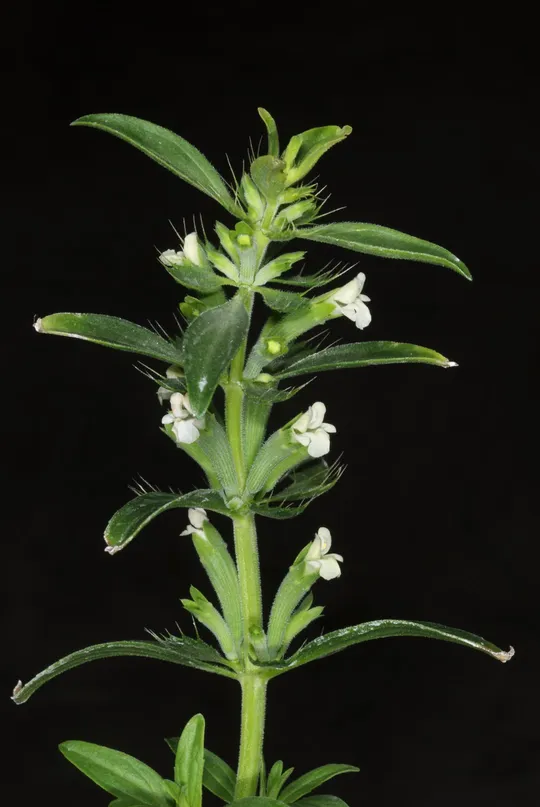Iberian Dragon's Head
Lallemantia iberica


Lallemantia iberica is found in the following regions in
Israel: Samaria, the Judean Mountains and the Judean Desert at 11 sites, although
there are in fact an estimated 25 sites. In southern Samaria, it is found in
Anatot. In the Judean Mountains, the species is extinct in the Jerusalem area, from
where it was collected twice during the 1920s and '40s. However, it is found in
in Gush Etzion, Dahariya and particularly in the southern Hebron Hills –
Aristoblia and in the vicinity of Susya. In the Judean Desert, L. iberica was collected only three times in the
Nabi Musa-Hyrcania area and Wadi Dragot. It was also found in the Binyamin
transition zone at the Rimonim Junction by Yair Or in 2009. On Mt. Hermon (outside
of the area covered by this book) L. iberica is extremely rare, and was found only
once in the montane transition forest on Mount Shalhavit in 1991.
Transition zone
shrubland, mainly on fallow fields and traditionally managed dryland
agriculture on rendzina and terra rossa soil.
Lallemantia is a small Irano Turanian genus that
consists of six species, most of them annuals found mainly in the arid areas of
Asia. Lallemantia iberica is extremely
similar to L.
peltata,
a more northerly species that grows in Turkey, Iran and the Caucasus, which is characterized
by round bracts. L. royleana, a tiny annual with broad leaves, also grows in our region. It is
found in relictual populations in southern Sinai, but spreads east along arid
Asia up to western China.
·
Lallemantia iberica is a rare plant, whose
sites are apparently on a decreasing trend, particularly in the Judean Mountains
near Jerusalem.
·
The population size on the sites usually
numbers only a few dozen plants. L. iberica has a good germination capacity and
if its habitat were not harmed, the continuity of its populations would be
assured.
·
The number of fallow fields and
traditionally managed agricultural fields on terra rossa soil is decreasing and
consequently the species' habitat is disappearing.
·
L. iberica is not protected in nature reserves.
·
Its global distribution is broad and it
is not globally endangered.
Specific sections of traditional agriculture and fallow
fields in the transition zones of the Judean and Samarian deserts where Lallemantia
iberica grows should be declared nature reserves. Thanks to its
good germination capacity, a large seed bank can be created within a few years
to rehabilitate damaged populations, create new backup populations in its range
and to preserve the species ex-situ in Botanical Gardens.
Lallemantia iberica has a broad distribution in the Middle East. It is found throughout the Anatolian Highlands
and eastwards to the entire Caucasus and Iran. It also grows in northern Iraq,
the Syrian Desert, Jordan and Israel (Gabrielian and Fragman-Sapir, 2008). This
is a common plant characteristic of arid areas which is extremely rare in our
region.
Lallemantia
iberica is a small annual plant of fallow and traditionally cultivated
fields in transition zones. The species is rare and its continued existence is
threatened by the reduction of available habitat. L. iberica
is not globally endangered.
Gabrielian, N. and Fragman-Sapir, O. 2008. Flowers of the Transcaucasus and Adjacent Areas. Gartner Verlag.
Current Occupancy Map
| 1000 squre meter pixel | 5000 squre meter pixel | 10000 squre meter pixel | |
|---|---|---|---|
| number of observations | 0 | 0 | 0 |
| in total pixels | 0 | 0 | 0 |
| Family | Lamiaceae |
| Classification | On the endangered species list |
| Ecosystem | High Semi-Steppe |
| Chorotype | Western Irano - Turanian |
| Conservation Site | Havat Ma’on Fields |
| Rarity |
1
2
6
|
|---|---|
| Vulnerability |
0
3
4
|
| Attractiveness |
0
0
4
|
| Endemism |
0
0
4
|
| Red number |
1
3.2
10
|
| Peripherality | N |
| IUCN category | DD EW EX LC CR EN VU NT |
| Threat Definition according to the red book | Vulnerable |
 Based on:
Based on:






